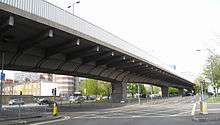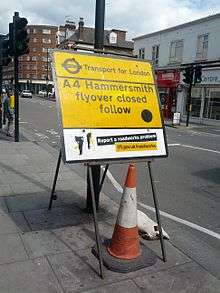Hammersmith flyover
The Hammersmith flyover is an elevated roadway in West London which carries the A4 arterial road over and to one side of the central Hammersmith gyratory system, and it links together the Cromwell Road extension (Talgarth Road) with the start of the Great West Road. It is one of the first examples of an elevated road using reinforced concrete.[5][8]
Hammersmith flyover | |
|---|---|
 | |
| Coordinates | 51°29′28″N 0°13′39″W |
| Carries | |
| Maintained by | Transport for London[1] |
| Characteristics | |
| Total length | 622 m (2,041 ft)[2] |
| Width | 18.6 m (61 ft)[3] |
| Longest span | 42.7 m (140 ft)[3] |
| No. of spans | 16[3] |
| History | |
| Architect | Hubert Bennett[3] |
| Designer | G. Maunsell & Partners |
| Constructed by | Marples, Ridgway and Partners |
| Construction start | January 1960[4] |
| Construction end | 16 November 1961[5] |
| Construction cost | £1.2[3]–1.3 million[6] |
| Opened | 16 November 1961[5] |
| Statistics | |
| Daily traffic | 85,549 (2011)[7] |

| |
Design
An elevated road employing reinforced concrete balanced cantilever beam supports with a single central column. The deck spine and wings are of hollow prestressed concrete design, with each span being tensioned by longitudinal tendons (four clusters, each of sixteen 29 mm (1.1 in) steel cables).[9] The flyover was designed by G. Maunsell & Partners, Consulting Engineers, led by Peter Wroth[10] and is 622 metres (2,041 ft) long.[2] When built the flyover included heating cables to "eliminate ice formation".[11] The system was initially successful,[12] though a £4800 bill for the 1962–63 winter "so shocked Hammersmith Borough Council that, as a protest, it cut off the electricity". London County Council paid the bill after this.[13]
The heating system became defective at some point a "long time" before 2000.[14]
History

Completed in 1961, it was one of the first examples of its design. Marples, Ridgway and Partners, a Westminster-based civil engineering contractor, built the flyover at a cost of £1.3 million.[6] The then Conservative Transport Minister Ernest Marples had been a Marples, Ridgway shareholder. To avoid a conflict of interest Marples undertook to sell his controlling shareholder interest in the company as soon as he became Minister of Transport in October 1959, although there was a purchaser's requirement that he buy back the shares after he ceased to hold office, at the price paid, should the purchaser so require.[15]
A large part of the churchyard of St Paul's Church, the parish church of Hammersmith, had to be cleared to allow the building of the flyover, and much of the churchyard wall and many of the graves were lost.[16]
Repair work

In December 2011 Transport for London (TfL) issued a statement that "damage to the ageing 1960s structure has been caused by water ingress, including salt water due to grit laid during the winter months, which has corroded and weakened the cables which help support the flyover".[1] TfL stated there was "a very remote possibility that Hammersmith Flyover [would] collapse".[17][18]
The Fulham & Hammersmith Chronicle claim that they were contacted on 14 December 2011 by a whistleblower who revealed that problems with the structure were far more severe than was being made public.[19][20] The flyover was closed to all traffic from 23 December 2011[21][22] to 12 January 2012 after structural defects were discovered.[8] From 13 January[8] to 27 May[23] the bridge was only open to a single lane of light traffic in each direction for repair work. TfL planned to strengthen six of the sixteen arches before the London 2012 Olympic Games and the remaining ten arches after the games.[24] New post-tensioned steel cables "are being installed in concrete blocks above and below the deck’s central reservation".[25] The repairs are now complete and extended the life of the bridge by 15 years.[26] The cost of repairs was estimated to be around £10 million.[27]
In June 2013 it was announced further repairs were required, a project estimated to cost £60m.[28]
Transport for London has announced that "The 18-month project will see the flyover strengthened, the bearings underneath the structure replaced, a new carriageway drainage system [fitted] and the entire flyover waterproofed and resurfaced." [29] TfL has said verbally that the flyover is otherwise sound, and that its life after repair is expected to be another 60 years. TfL announced on 10 August 2015 that repair work to the bridge is now complete.
Replacement Tunnel
It has been proposed that the flyover be replaced with a tunnel as a longer term solution. A group of architects, including Assael Architecture and Simone de Gale, ran an event as part of London Festival of Architecture in 2012 to introduce the idea and gauge public interest.[30] Following a mixed but mostly positive response, the West London Link[31] was set up to explore the options in more detail.
Three options were presented to the public in February 2014.[32]
Similar projects have been undertaken in other cities for example the Alaskan Way Viaduct replacement tunnel in Seattle. Former Mayor of London, Boris Johnson, suggested that the bridge may be replaced by a tunnel in the future.[26]
References
- "Hammersmith flyover to remain closed next week" (Press release). TfL. 30 December 2011. Retrieved 13 January 2012.
- McCarthy, Michael (9 January 2012). "Race against clock to fix vital transport artery for Olympics". The Independent. London.
- "Hammersmith Flyover". Engineering timelines. Retrieved 13 January 2012.
- Basham, Rupert (2 February 2012). "Feature: The birth of the Hammersmith Flyover". Hammersmith & Fulham Chronicle. Retrieved 2 February 2012.
The volume of vehicles was such an issue that during the flyover's 22-month construction period, traffic had doubled in the area, reaching a peak of 70,000 cars a day.
- Rawlinson, S. R. J.; Stott, P. F. (1962). "The Hammersmith Flyover (Includes Plates.)". ICE Proceedings. 23 (4): 565. doi:10.1680/iicep.1962.10813.
- Doughty, Steve (3 January 2012). "The Hammersmith flyover: One of the greatest examples of stuff-you politics in modern times". Daily Mail. London. Retrieved 13 January 2012.
- "Hammersmith and Fulham Traffic Counts: Count Point id 16110". Department for Transport. Retrieved 22 May 2013.
AADF for All Motor Vehicles 2011 85,549.
- "Hammersmith Flyover reopens to light traffic". BBC News. 13 January 2012. Retrieved 13 January 2012.
- Engineering Timelines: Hammersmith Flyover
- Milligan, G. (December 1991). "Charles Peter Wroth 1929–91". Géotechnique. 41 (4): 631–635. doi:10.1680/geot.1991.41.4.631. ISSN 0016-8505.
- Information, Reed Business (13 December 1962). "BICC (advert)". New Scientist. 16 (317): 693. ISSN 0262-4079. Retrieved 13 January 2012.
- The Surveyor and Municipal and County Engineer. 122.
The road heating of the Hammersmith flyover has been particularly successful during this prolonged cold spell
Missing or empty|title=(help) - "Snow on the Roads". The Economist. 214 (1). p. 55.
The bill, at £4800, for heating the Hammersmith flyover in the winter of 1962-63 so shocked Hammersmith Borough Council that, as a protest, it cut off the electricity. (The LCC now pays.)
- "Freedom of Information Request: Hammersmith Flyover Heating Correspondence". WhatDoTheyKnow.com. 17 January 2012. Retrieved 25 January 2012.
- Personal Statement - The Minister of Transport (Mr. Ernest Marples), Hansard, House of Commons, 28 January 1960
- "St Paul's Churchyard and St Paul's Green". London Gardens Online. Retrieved 21 October 2014.
- "TfL report warned of Hammersmith Flyover collapse risk". BBC. 3 December 2012. Retrieved 4 December 2012.
- "Traffic modelling of A4 Hammersmith flyover closure (Hammersmith Flyover Emergency Preparedness Plan v00e.pdf)". WhatDoTheyKnow. 13 April 2012. Retrieved 4 December 2012.
- Hammersmith Flyover 'unsafe' claims TfL whistleblower
- Hammersmith Flyover Is 'Unsafe'
- "Hammersmith flyover closed due to structural defect". BBC News website. 23 December 2011. Retrieved 23 December 2011.
- "TfL statement on the Hammersmith flyover". Transport for London website. 23 December 2011. Retrieved 23 December 2011.
- "Hammersmith Flyover fully opens after repairs". BBC News. 28 May 2012. Retrieved 28 May 2012.
- "Hammersmith flyover to reopen for cars and light traffic as vital repair works continue" (Press release). TfL. 11 January 2012. Retrieved 13 January 2012.
- Lynch, Declan (9 February 2012). "Hammersmith flyover cable replacement starts this week". New Civil Engineer. Retrieved 13 February 2012.
- Dominiczak, Peter (26 January 2012). "Hammersmith flyover? The solution could be to dig a tunnel, says Boris". London Evening Standard. Archived from the original on 28 January 2012. Retrieved 26 January 2012.
- Lynch, Declan (23 February 2012). "Hammersmith flyover: returning to full strength". New Civil Engineer. Retrieved 25 February 2012.
- Prynn, Jonathan (13 June 2013). "Hammersmith flyover needs £60m repair job after £10m emergency work two years ago". London Evening Standard. Retrieved 13 June 2013.
- "Hammersmith flyover strengthening and refurbishment". Transport for London. 22 October 2013. Retrieved 22 October 2013.
- "Archived copy". Archived from the original on 2 December 2013. Retrieved 14 November 2013.CS1 maint: archived copy as title (link)
- http://www.westlondonlink.com
- "Archived copy". Archived from the original on 1 March 2014. Retrieved 25 February 2014.CS1 maint: archived copy as title (link)